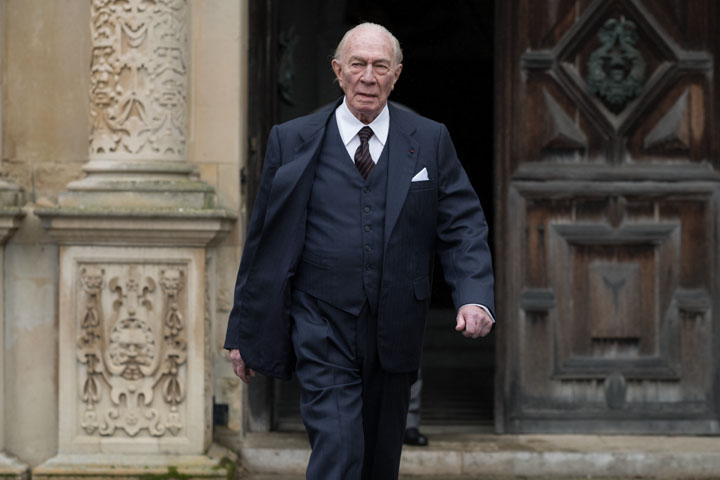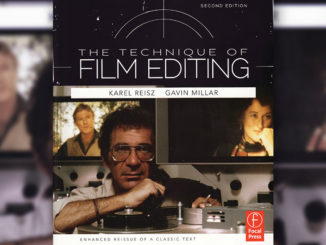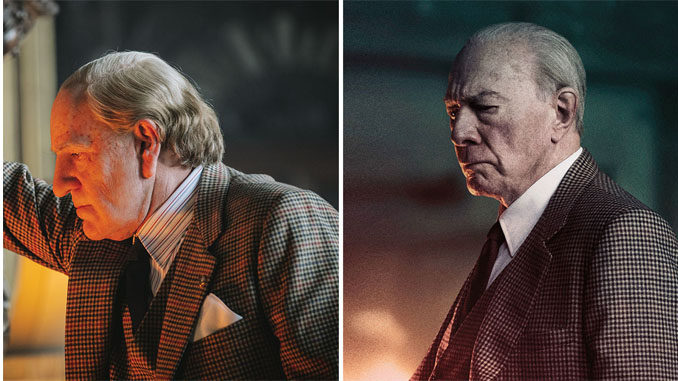
by Steve Hullfish • film stills courtesy of Sony Pictures Entertainment
The production and post-production of Ridley Scott’s All the Money in the World is one of the most fascinating filmmaking stories of the past year, perhaps the decade. The film tells the true story of the 1973 kidnapping of 16-year-old J. Paul Getty III (Charlie Plummer), grandson of billionaire J. Paul Getty (originally Kevin Spacey, but now Christopher Plummer). The film follows the efforts of the younger Getty’s mother (Michelle Williams) as she tries to get the ransom money from her wealthy father-in-law. Eventually, she’s aided in her efforts by the billionaire’s lawyer, Fletcher Chase (Mark Wahlberg). The film was initially slated for a December 22, 2017 release date through Sony’s TriStar Pictures.
Originally, Scott had wanted Christopher Plummer for the central role of J. Paul Getty, but Sony pushed for the more bankable Kevin Spacey. However, just as the completed film was about to enter its final mix, allegations of sexual misconduct against Spacey threatened to derail the movie (as it had done the actor’s other projects). The marketing campaign (including the trailer) for the film was already in full swing.
Instead of allowing the allegations to scuttle the film’s release, or turn it into a cinematic scourge if released as is, Sony and Scott announced that he would re-shoot all of the Spacey scenes with his preferred choice of Plummer in the role. This meant unlocking the picture and shooting and re-cutting 22 scenes of the movie in a matter of weeks in order to maintain the original release date.
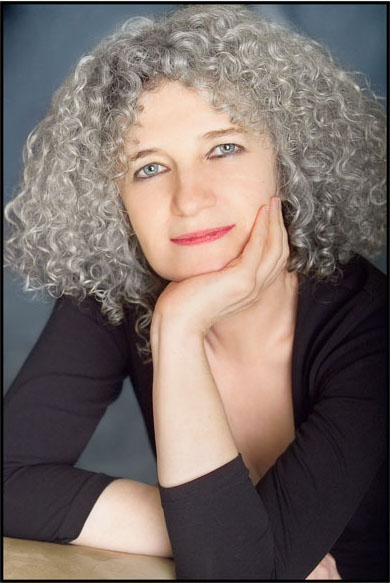
Photo by Armen Asadorian
This incredible and unprecedented post-production challenge was placed on the shoulders of editor Claire Simpson. Scott had previously partnered with Simpson on Someone to Watch Over Me (1987). Simpson also had worked with Scott’s late brother, Tony, on The Fan (1996). Simpson’s other notable credits include Oliver Stone’s Platoon (1987), for which she won the Oscar for Best Editing, and The Constant Gardener (2006), which garnered her an Academy Award nomination.
The timeline of events of this extraordinary post-production schedule, as documented by Simpson, gives an idea of the pressures of this unusual production.
Tuesday, November 7, 2017 – The original film starring Spacey is locked and Scott is scheduled to review the final mix at Twickenham Studios in London. Scott phones Simpson to say that he is on his way to New York instead, but he does not say why. The film’s premiere, which was scheduled as the closing film of the AFI Film Festival in LA on November 16, is cancelled.
Wednesday, November 8, 2017 – In New York City, Scott secretly meets with Plummer, who agrees to play the role of J. Paul Getty. Scott returns to LA. Sony announces that Scott will re-shoot Spacey’s scenes in the film and replace him with Plummer.
Thursday, November 9, 2017 – Since the film was to have been completed by mid-November, numerous members of the post team had made other plans afterwards. But Simpson and Teresa Kelly, the post supervisor, wrangle the team back together and work out a schedule based on an unchanged delivery date for foreign and domestic distribution. Since the scenes that need to be re-shot are evenly distributed throughout the reels, no reel is locked.
It is determined to treat each new scene as a separate entity, which would then be inserted into the appropriate reels. Overlaps will need to be finessed and music will have to be re-cut. There is no time to compose or score new music. Music editors Tony Lewis and Arabella Winter must re-shape many of the cues around the new rhythms and pace of the dialogue.
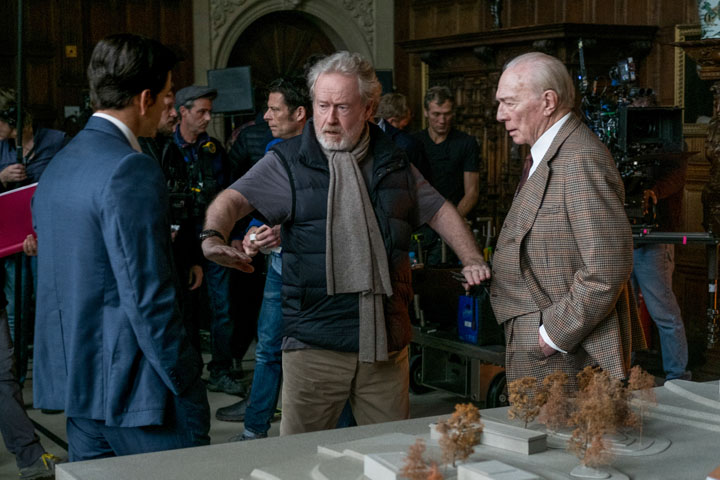
Monday, November 13, 2017 – The production crew re-assembles and pre-production starts. Scott meets with all department heads of the production, including visual effects supervisors. Since visual effects is going to be the most time-challenged department, all green screen work is scheduled for the first day of production.
Tuesday-Friday, November 14-17, 2017 – While the production prepares for the reshoots, the post team locks the sound mix and the color correction on all the scenes which do not feature Spacey. (Friday the 17th was to have been the original end date for Simpson and the editorial team, following the planned premiere the evening before.)
Monday, November 20, 2017 – Production begins with five days scheduled at Sutton House in London, posing as the Getty Estate. Upon completion of each scene, the camera data is couriered to the cutting room in London, where a digital lab is set up. By the afternoon, the morning’s shoot is processed and ingested into the Avid. By the evening, the dailies are ready to view after the day’s wrap, and are then cut the next morning. As each scene is done, it is sent to the sound department for Foley and dialogue cleanup. There is no time for ADR, so the on-set recordings must be perfect.
Saturday, November 25, 2017 – Production moves to Rome, Italy. The cutting room remains in London.
Sunday-Wednesday November 26-29, 2017 – Dailies from the Rome re-shoot are sent through a dedicated FTP server and the edited material is sent back to Scott in Rome for review and notes. Production wraps on the 29th. A re-cut trailer featuring Plummer in place of Spacey is released the same day.
Thursday, November 30, 2017 – Scott returns to London and screens the completed cut on his 80th birthday.
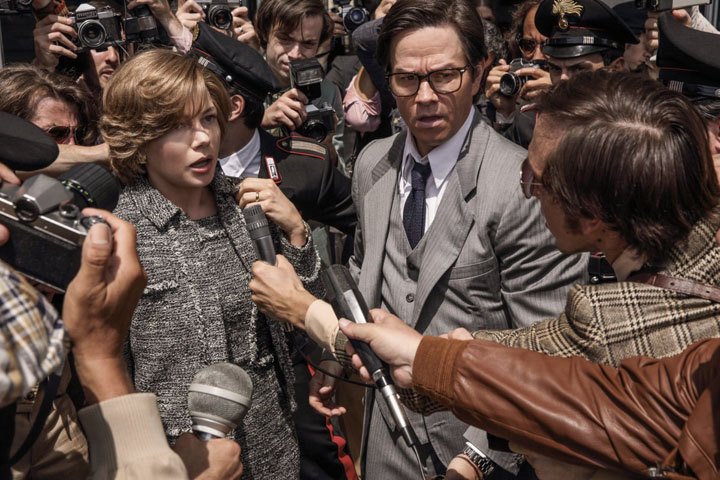
Sunday, December 3, 2017 – A digital cinema package (DCP) is made for the Foreign Press Association in order to be considered for Golden Globe Awards consideration. (The nominations, which would be announced December 11, include three for All the Money in the World: Scott for Best Director, Michelle Williams for Best Actress and Plummer for Best Supporting Actor; none of them will win. In January, Plummer will receive an Oscar nomination, the only one for the film.)
Tuesday, December 5, 2017 – Scott and Simpson screen the final mix with all the new scenes incorporated.
Wednesday, December 6, 2017 – All visual effects are finalized and the DI is updated. Color correction is completed in LA.
Thursday, December 7, 2017 – Scott flies back to LA and the final DCP is screened — just under a month after announcing the film would be re-cut, and less than three weeks after receiving the new dailies.
Friday, December 8, 2017 – Simpson packs up the cutting room and prepares to leave for her home in Italy.
Monday, December 18, 2017 – A month and a day after its originally planned premiere date, the film premieres at the Academy of Motion Picture Arts and Sciences’ Samuel Goldwyn Theatre in Beverly Hills.
Monday, December 25, 2017 – All the Money in the World is released, three days after its originally announced release date, as Sony allegedly wanted to avoid competition from The Greatest Showman, which opened December 20.
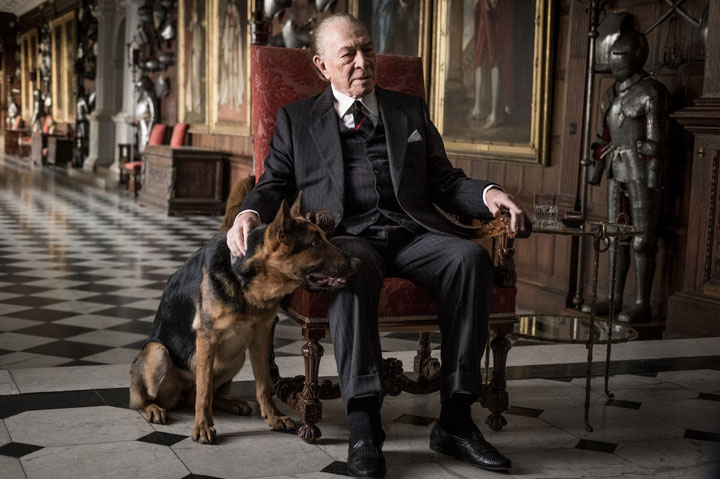
• • •
In an exclusive interview from her home in Italy, Simpson shared with CineMontage her experiences on the 11th-hour re-cut of All the Money in the World.
The original news about Spacey had a deep impact on the crew, according to the editor. “We were all shocked and saddened by the news of the allegations against Kevin Spacey of sexual harassment,” explains Simpson. “When it was announced that Netflix would drop him from future projects, we were anticipating that we would be the next casualty — but Ridley does not go down without a fight.”
When it was announced that all of Spacey’s scenes would be re-shot with Plummer in the role, Simpson says her first reaction was to make sure she had enough crew to cope with any extended schedule. “Many staff had planned vacations or were about to start other film,” she reveals. “But without exception, the entire crew rescheduled their plans. Too much hard work by cast and crew had gone into making the film and we did not want to see that work squandered.
“There was a general feeling of euphoria, of renewed energy and focus,” she adds. “We had 22 scenes to be re-shot and edited with sound effects and dialogue remixed, music re-cut and visual effects completed in three weeks.”
For the editor, the logistical challenges were clear: “It had to be conducted like a military campaign with absolute precision if we were to deliver within such a tight time frame. There was no room for mistakes. Ridley drew storyboards for all the scenes. There was incredible synergy between all the departments.
“Once production started, it was imperative that we received the dailies as fast as possible,” Simpson continues. “The decision was made to split the film after each scene had been completed so that the scenes could be couriered to us immediately. By the afternoon, I was editing the material from that morning’s shoot so that by the time Ridley arrived in the cutting room after wrap, he was able to see at least one cut scene from the day’s shoot, and then dailies from that afternoon. Also, cut scenes would be disseminated to sound, music and visual effects daily so that they could work concurrently with picture.”
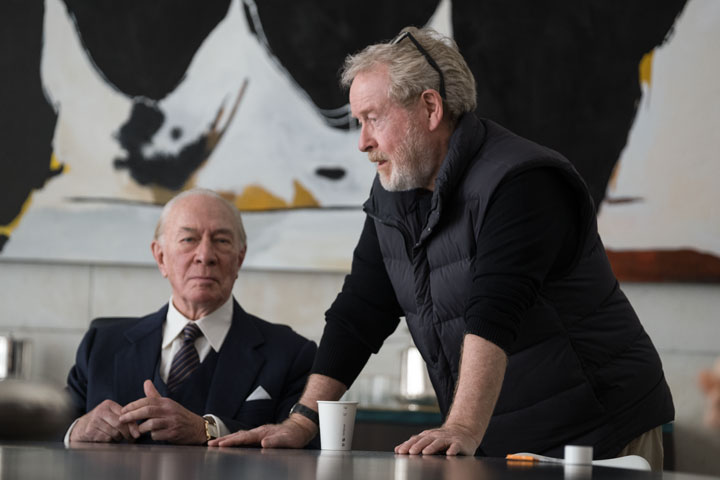
The only scene that wasn’t completely re-shot on location was part of a montage at the beginning of the film, depicting the elder Getty in the Arabian desert, shaking hands with sheiks, according to Simpson. “To re-shoot the desert scene, originally shot in Jordan, was out of the question because of time and money,” she attests. “We therefore contrived to visually pluck out one actor and replace him with the other.
The visual effects department painted out Spacey and prepared the background plates of the desert landscape and Arab actors. Plummer was filmed against green screen, replicating the same action, shaking hands with imaginary Arab sheiks. The green screen was shot on the first day of production so as to give the effects department the maximum time to blend the elements together.”
The creative challenges were just as daunting as the logistics. This was not simply a matter of replacing one performance with another. With the exception of the green-screened Arabian scene, Plummer’s scenes were shot in their entirety — with all the actors assembled for the re-shoot, the editor explains.
“There was no rewriting, but Plummer’s interpretation of the character of J. Paul Getty was very different from Spacey’s,” Simpson offers. “Plummer’s rhythms and inflections were entirely different, even though he was delivering pretty much the same dialogue. Plummer, being close in age to Getty, had the advantage of not being plastered with prostheses. He could muster all the guile, mischief and obdurate stubborness of an elderly gentleman at the drop of a hat.”
According to Simpson, it was not necessary to reshape the existing scenes surrounding the new Plummer footage, with the exception of a sequence toward the end of the film, where the young Getty was escaping the kidnappers, which was intercut with the death of his grandfather.
For the most part, the coverage of Plummer that Scott shot was very close to what had been shot of Spacey. “By and large the coverage was very similar except for two scenes, which were shot in entirely different locations, and one of which had entirely different action,” Simpson says. One scene showed the elder Getty character buying a masterpiece painting, but for that sequence, the original location was no longer available.
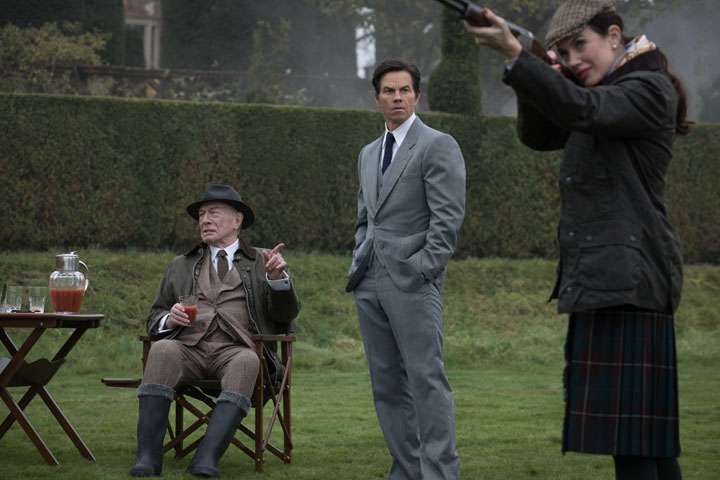
For the other scene, the location change was necessitated by the change in seasons. “The film had been shot in a roasting, hot summer and re-shoots were done in a cold and frosty winter,” Simpson recounts. “Chace’s first meeting with Getty had originally taken place in the garden of his estate, with young ladies playing badminton in flimsy white dresses while Chase and he drank chilled champagne. The sound designer had laid in distant shooting from a hunt in the background. This had appealed to Ridley, and I think it inspired him to re-stage the scene in a wintery garden with skeet shooting. This not only allowed the ladies to shed their light summer garb for country tweeds, but also Chase had the opportunity to show off his prowess with a firearm.”
The re-shoot posed challenges for the sound team as well. “Since the seasons between shooting had changed, the ambiences were completely different — particularly for the exterior scenes,” Simpson explains. “Birds had migrated and what had been a sweet summer breeze wafting through green, leafy foliage in the original shoot was replaced by gardeners sweeping up dried, fallen leaves. The sound department had their work cut out for them.
“Apart from that, the staging of most of the scenes was identical,” she continues. “[DP] Dariusz Wolski’s lighting was so accurate that it actually enabled me to steal a close-up or two of Michelle Williams from the original shoot.”
Simpson describes working through one of the challenges she faced even before the re-shoot: “Except for the opening 20 minutes, in which there are several flashbacks relating to the history of the family and the making of the Getty fortune, the film is structured pretty much as scripted, following the chronology of the true events. The flashback proved to be somewhat challenging for an audience to follow, so we played around with the structure there.”
Throughout the process of editing the film, Simpson appreciated her collaborative relationship with the director, saying, “Ridley is a great communicator. He is a trained artist and loves to draw storyboards, which are disseminated amongst the heads of departments. By the time production starts, he has the whole architecture of the scenes in his head.”
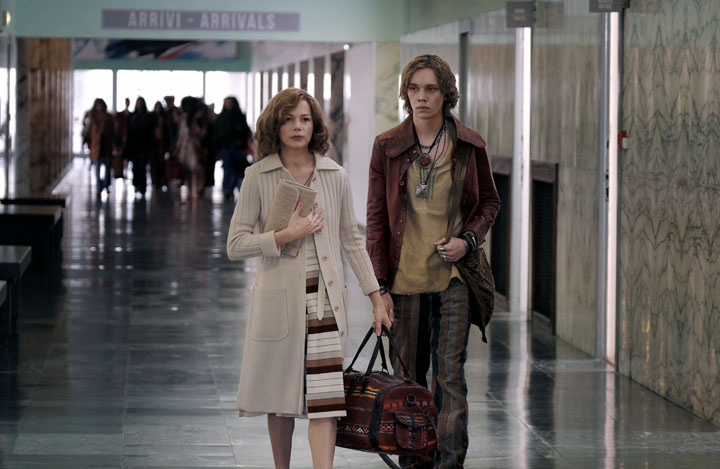
One of the great rewards she finds working with Scott is the return of the tradition of watching dailies each evening as a team. “Every day, after the shoot, we screen dailies,” says Simpson. “It’s a great opportunity for all the department heads to get together and talk about the work, and Ridley articulates his intentions behind the scenes in a vivid and humorous way. It’s usually accompanied by a glass of wine and aperitivi, so the atmosphere is very relaxed.
“It’s a great launching pad for the editing process,” she adds. “And editorial feels integrated with the production, as opposed to separate and distinct from it — which often happens when the discipline of screening dailies together no longer exists. Screening dailies for us becomes an enjoyable reward at the end of the day.”
Once dailies screenings are complete, Scott is not one to want to see numerous iterations of cut scenes. “Ridley likes to be surprised,” Simpson maintains. “He tries to remain as objective as possible and not get ‘contaminated’ by too many screenings. He does not like to view an assembly, but he will have seen and commented on all cut scenes during the shoot. We screen the film only when we have made significant progress.”
In the end, as Simpson re-cut the film with the Plummer re-shoots, she benefited from the work she’d already done with the Spacey scenes. “Remember, I had already had a dry run at the scenes in the original version,” she asserts. “The only unknown was how Plummer would interpret the character, and how that would affect the other actors performances and the rhythm of the scenes. But that’s what made it exciting and exhilarating.”
Three weeks to the day after Simpson was supposed to return home to Italy, she finally packed up her cutting room and headed for the airport, completing one of the most extraordinary post-production stories in recent history.
